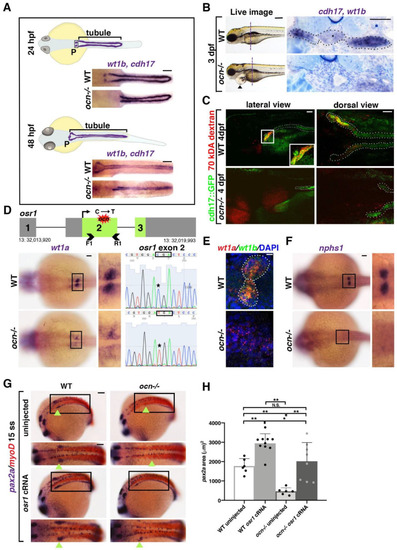FIGURE
Figure 1
- ID
- ZDB-FIG-221211-177
- Publication
- Drummond et al., 2022 - osr1 Maintains Renal Progenitors and Regulates Podocyte Development by Promoting wnt2ba via the Antagonism of hand2
- Other Figures
- All Figure Page
- Back to All Figure Page
Figure 1
|
Figure 1. The ENU mutant ocn has a proximally abrogated pronephros due to a lesion in the gene osr1. (A) At 24 hpf, the zebrafish pronephros contains two clusters of podocytes (P) and two nephron tubules. By 48 hpf, the pronephros is functional as the podocyte progenitors have migrated to the midline and fused. In ocn−/− mutants, podocyte progenitors (wt1b) are reduced at both stages. The pronephric tubules (cdh17) were truncated at 24 hpf, which became more dramatic at 48 hpf. Scale bar is 50 μm. (B) A live time course of ocn revealed pericardial edema beginning at 72 hpf, as indicated by black arrow heads. This fluid imbalance was symptomatic of organ dysfunction. Scale bar is 70 μm. WISH experiments to view podocytes and tubules (wt1b, cdh17) were also conducted at 72 hpf. JB-4 serial sectioning was conducted on three WT and three ocn−/− embryos to examine the anterior pronephros; the location is marked by the dashed vertical line. WT siblings had an intact pronephros (dotted outline), including a glomerulus (asterisk) with two tubules. Mutant sections of this same region had no discernable blood filter or tubule structure. Scale bar is 50 μm. (C) At 48 hpf, ocn::cdh17::GFP embryos were injected with 70 kDA rhodamine dextran (red). These embryos were assessed at 96 hpf. Nephron tubules are shown by the dotted outline. WT siblings exhibited no edema and appeared to uptake the dextran in the proximal region, as indicated by yellow coloration (inset). However, in mutants with pericardial edema and truncated tubules, there was no evidence of dextran within the tubule, suggesting that active uptake was not occurring in these mutants. Scale bar is 15 μm for lateral images and 50 μm for dorsal views. (D) After assessment of the genetic candidates obtained via whole genome sequencing, osr1 appeared to be an attractive possibility due to a C to T SNP that was predicted to cause a premature stop codon. The predicted lesion (red shape) is located in exon 2 of osr1. We designed primers that flanked exon 2 (arrow heads) for Sanger sequencing. Embryos with reduced wt1a WISH staining exhibited a “TGA” codon within exon 2 of osr1 that is normally a “CGA” codon in WT embryos. Scale bar is 30 μm. (E) To confirm that wt1a+ podocytes were reduced in ocn−/−, FISH with wt1a and wt1b was performed at 24 hpf. There were little to no double-positive cells seen in genotype-confirmed mutants, whereas both clusters of wt1a/b+ podocytes were evident in WT embryos. Scale bar is 10 μm. (F) The slit diaphragm marker nphs1 was similarly reduced in 24 hpf ocn mutants. Scale bar is 50 μm. (G,H) At the 15 ss, pax2a marks the developing IM, the beginning of which is shown with green arrowheads. In ocn−/−, the anterior region of pax2a is decreased. When ocn−/− was injected with osr1 cRNA, pax2a expression was restored. Interestingly, pax2a was significantly expanded in WT embryos injected with osr1. Absolute area measurements of pax2a were taken from somites 1–5. p-values: ** p < 0.001, * p < 0.05, N.S. = not significant. Scale bar is 50 μm.
|
Expression Data
| Genes: | |
|---|---|
| Fish: | |
| Anatomical Terms: | |
| Stage Range: | 14-19 somites to Day 4 |
Expression Detail
Antibody Labeling
Phenotype Data
| Fish: | |
|---|---|
| Observed In: | |
| Stage Range: | 14-19 somites to Day 4 |
Phenotype Detail
Acknowledgments
This image is the copyrighted work of the attributed author or publisher, and
ZFIN has permission only to display this image to its users.
Additional permissions should be obtained from the applicable author or publisher of the image.
Full text @ Biomedicines

